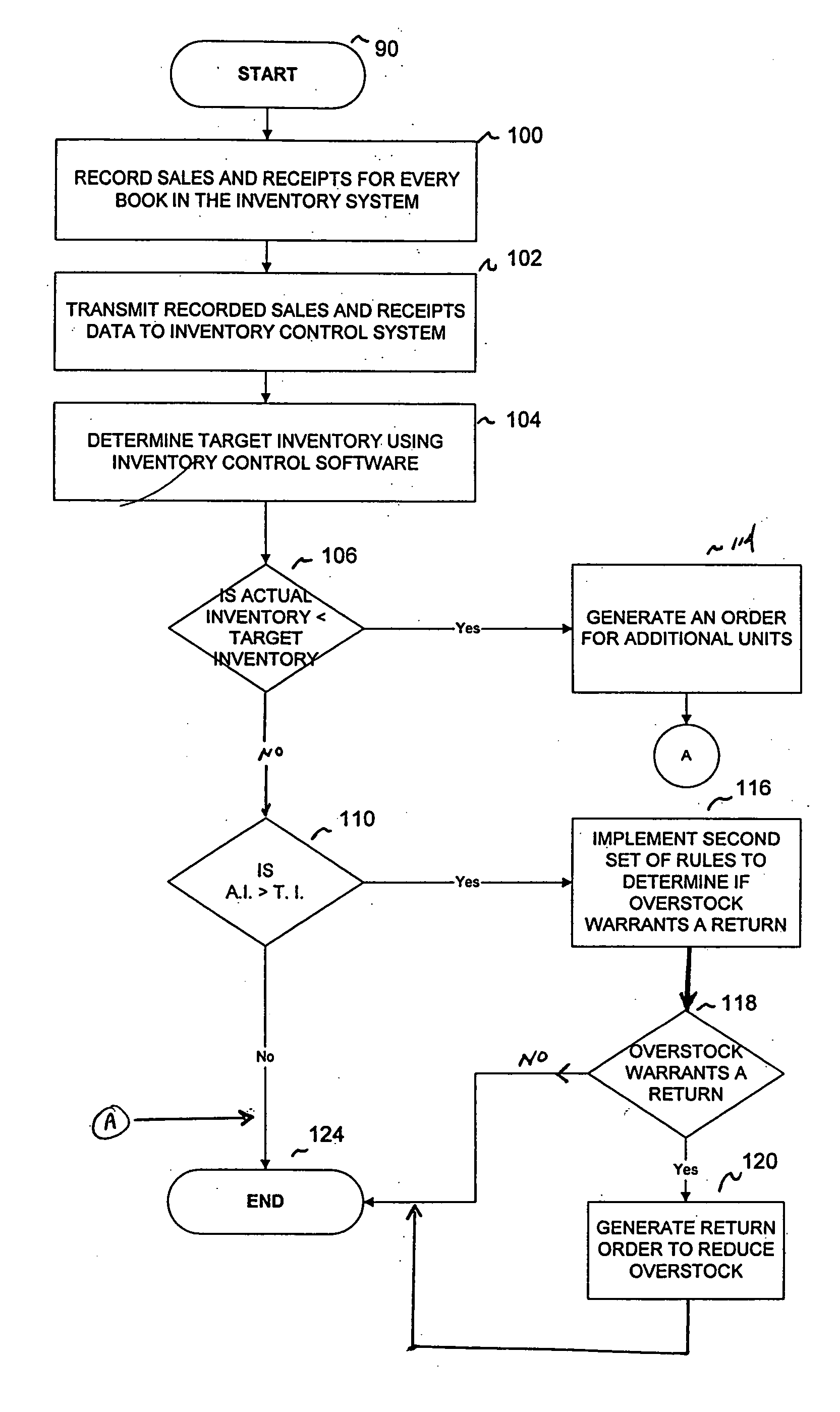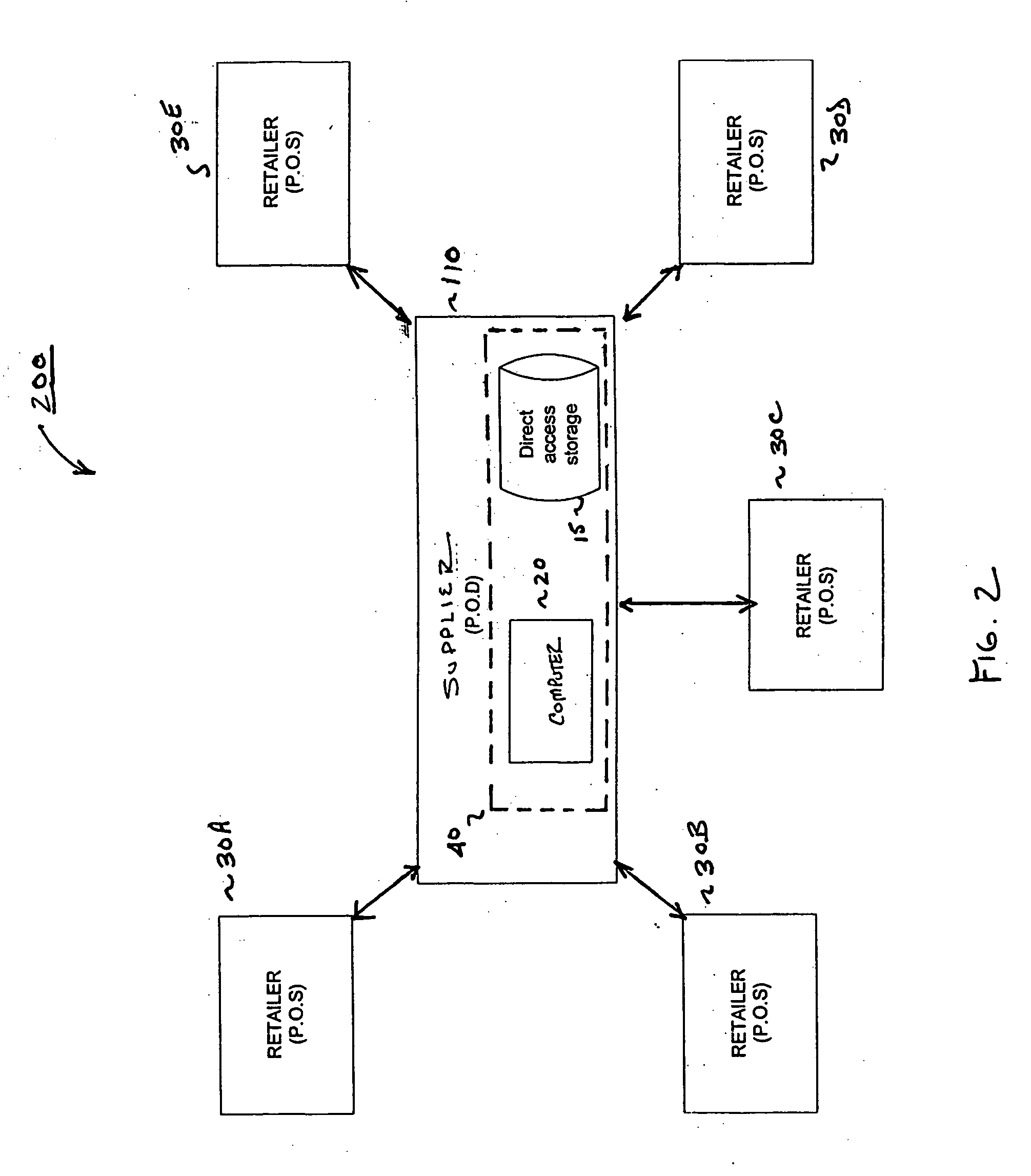System and method for automatically controlling inventory
a technology of automatic control and inventory, applied in the field of improving business efficiency, can solve the problems of large number of decisions that need to be made by a buyer in a short period of time, human buyers are limited in the number of decisions, and achieve the effect of maximizing the return on investmen
- Summary
- Abstract
- Description
- Claims
- Application Information
AI Technical Summary
Benefits of technology
Problems solved by technology
Method used
Image
Examples
first embodiment
[0028]FIG. 1 is an illustration of a first embodiment of the system 100 of the present invention. In this embodiment, the suppliers and retailers are configured in a star topology. Star topologies are well known in the field of networking, for example, and describe a configuration whereby a central hub forms a common connection point to a plurality of devices which form the spokes of the star. In the present context of inventory control, situated at the central hub of the star is shown a single point-of-sale (P.O.S) business 60 (i.e., retailer). The P.O.S. 60 is a common connection point to a plurality of point-of-distribution (P.O.D.) businesses 50A-E (i.e., suppliers).
[0029] Also shown, associated with the retailer (P.O.S) 60 is a computer 20 which runs the inventory control software of the invention. The inventory control software performs a number of functions including accessing the stored sale and receipt information. The software also accesses current inventory information, ...
second embodiment
[0030]FIG. 2 is an illustration of a second embodiment of the system 200 of the present invention. In this embodiment, the suppliers and retailers are configured in a star topology, similar to that described in the first embodiment, however, in the present embodiment, the central hub of the star is reserved for a single point-of-distribution (P.O.D) business 110 (i.e., supplier) whereby the P.O.D. 110 is the common connection point to a plurality of point-of-sale (P.O.S.) businesses 30A-E. In this embodiment, the inventory control system 40 is centrally situated at a hub, i.e., point-of-distribution (P.O.D) business 110 (i.e., a supplier) that supplies the one or more point-of-sale (P.O.S) businesses (i.e., retailers) 30A-E. The present configuration is in accordance with a star topology in which the supplier (i.e., P.O.D) 110 is situated as a central hub connected to the point-of-sale businesses 30A-E each forming one spoke of the hub.
[0031] In this embodiment, each point-of-sale ...
third embodiment
[0032]FIG. 3 illustrates a third embodiment of the invention. This embodiment describes a hybrid system 300 which combines features of the first and second embodiments. In particular, system 300 includes two subsystems 161, 163 where subsystem 161 is configured in accordance with the topology of FIG. 2. That is, subsystem 161 includes a single supplier (P.O.D) which supplies product to a plurality of retailers (P.O.S.s) 90A-N, 90X. Subsystem 161 is distinguishable from the configuration of FIG. 2 in that it concerns only a particular product set, i.e., product set “A”.
[0033] Also shown is subsystem 163 which is configured in accordance with the topology of FIG. 1. That is, subsystem 163 includes a single Retailer (P.O.S), i.e., Retailer X, that receives product from a plurality of suppliers (P.O.S.s) 90A-N. Subsystem 163 is distinguishable from the configuration of FIG. 1 in that it concerns only a particular product set, i.e., product set “B”.
[0034] Retailer X is shown to further...
PUM
 Login to View More
Login to View More Abstract
Description
Claims
Application Information
 Login to View More
Login to View More - R&D
- Intellectual Property
- Life Sciences
- Materials
- Tech Scout
- Unparalleled Data Quality
- Higher Quality Content
- 60% Fewer Hallucinations
Browse by: Latest US Patents, China's latest patents, Technical Efficacy Thesaurus, Application Domain, Technology Topic, Popular Technical Reports.
© 2025 PatSnap. All rights reserved.Legal|Privacy policy|Modern Slavery Act Transparency Statement|Sitemap|About US| Contact US: help@patsnap.com



